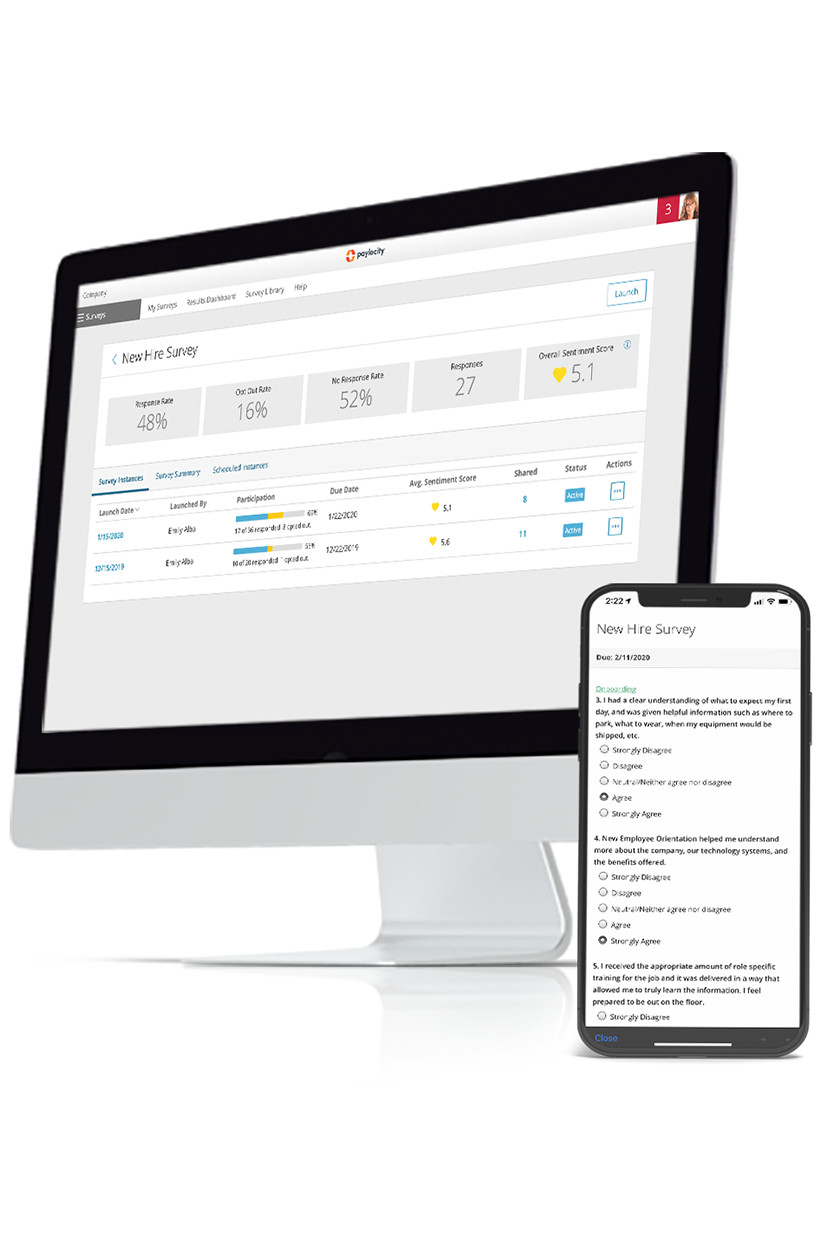resources
Decoding the Employee Experience: Top Retention Factors
October 06, 2023
Discover three top drivers of retention and how they can be addressed to improve the employee experience.
Blog Post

Why does an employee stay with their employer?
In the last few years, businesses have become increasingly aware of the impact employee experience has on retention. From “Quiet Quitting” to “The Great Resignation,” employees are not afraid to show their dissatisfaction when companies fall short of expectations. Today, even in an uncertain economy, many industries continue to encounter labor shortages and high turnover.
To help organizations stem the tide of turnover, Paylocity evaluated common employee survey questions to determine what drives retention. These insights can help organizations identify and correct employee experience weaknesses so that workers want to stay longer.
In this article, we’ll discuss some of our conclusions and unpack three retention drivers to understand how they correspond to creating a positive employee experience.
Why and How We Study Employee Retention
Retaining employees is a crucial goal for businesses and HR professionals. Losing an employee can cost the organization from 50% to 200% of the employee’s annual salary or more. Beyond those hard costs, high employee turnover can impact morale internally and affect external recruitment efforts if your reputation as an employer declines.
So, what can businesses do to improve employee retention?
There is a long list of factors that contribute to retention, which can make it challenging to decide where to focus first. In previous articles, we’ve looked at some of the common reasons employees stay, including competitive compensation, manager engagement, and flexible work environments. We also discovered some differences between what employees want and what HR thinks they want.
The importance of a positive employee experience is well documented and goes beyond retention. In their HR Trends Report for 2023, McLean & Company found organizations that are successful at establishing a positive employee experience are much more likely to report high performance across multiple measures, including innovation, workforce productivity, and overall organizational performance.
How We Think About Retention
Usually when researchers study predictors of employee retention, they look for correlations with employees’ stated intent to leave their current employers, typically determined through a survey. This measurement approach can provide useful information but has some drawbacks.
When employees are asked about their intentions to stay at their place of work, understandably they may feel uncomfortable answering honestly. This could result in biased or incomplete results. They might worry that sharing their true thoughts about leaving could negatively impact their relationship with their manager and their future with the company.
Instead of relying on employees’ self-reported intent, we went a step further and measured actual employee retention. We compared engagement survey responses and the number of years workers remained with their employer to unlock deeper insights about what truly drives people to stay with or leave their organizations.
How We Measure Employee Sentiment and Job Satisfaction
While some indicators (such as compensation) can be objectively measured without surveying employees, ultimately what matters is how employees subjectively think and feel. We wanted to know what measures of employee sentiment best predicted higher retention rates.
To identify important drivers of retention, we started by constructing a list of common employee survey questions. We then analyzed a dataset of responses to these survey questions and observed actual retention for about 8,500 anonymized workers. This allows us to see how these survey questions correlate with retention using a survival model. (See Appendix A for details about survival models.)
In the table below, you can see a sample of the survey questions we evaluated and the drivers they represent. By “driver” we mean a category of employee experience in which different questions can measure different aspects. For each of the questions, employees were asked how much they agree or disagree with the statement.
Before you read about our results, take a minute to see if you can guess which drivers are the most predictive of retention.
Sample Employee Experience Survey Questions
|
Driver |
Statement |
|
Empowerment |
Senior management is genuinely interested in employee opinions and ideas. |
|
Career opportunities |
The organization’s policies for promotion and advancement are fair. |
|
Communication |
Leadership does a good job communicating change across the organization. |
|
Inclusion |
We work to attract, develop, and retain people with diverse backgrounds. |
|
Engagement |
Doing my job well gives me a sense of personal satisfaction. |
|
Engagement |
My work is challenging, stimulating, and rewarding. |
|
Manager support |
My manager encourages and empowers me to take initiative and suggest improvements. |
|
Peer relationships |
My co-workers and others in the organization increase my overall job satisfaction. |
|
Enablement |
I have the support and necessary systems in place to get my job done. |
|
Recognition and Rewards |
I am satisfied with how frequently my company recognizes employees' individual performance and work contributions. |
|
Strategy |
I understand the connection between my work and my organization’s strategy. |
|
Work-Life Balance |
The balance between my work and personal commitments is right for me. |
Our Findings: Top Three Retention Factors
On average, our results show employees’ chances of being retained each year decrease over time. But how quickly they decrease varies significantly based on the degree to which they feel engaged, empowered, or enabled.
The statements below had the widest variances between employees who Strongly Disagree or Strongly Agree and the number of years they remained with their employer.
- My work is challenging, stimulating, and rewarding.
- Doing my job well gives me a sense of personal satisfaction.
- I have the support and necessary systems in place to get my job done.
- Senior management is genuinely interested in employee opinions and ideas.
For example, in the case of the statement, “My work is challenging, stimulating, and rewarding,” our model predicts an employee who answered Strongly Disagree has about a 39% chance of being retained for five years or more. When we compare this with employees who Strongly Agree with the statement, the likelihood of retention is about 73%. That means they are 34% more likely to stay!
One goal of employee surveys is to prevent turnover before it happens. So, what are these statements really saying about the employee experience and the factors that sway an employee to stay?
To answer this question, we looked at the experience drivers associated with these statements and saw that three themes rose to the top:
- Engagement
- My work is challenging, stimulating, and rewarding.
- Doing my job well gives me a sense of personal satisfaction.
- Empowerment
- Senior management is genuinely interested in employee opinions and ideas.
- Enablement
- I have the support and necessary systems in place to get my job done.
Download the Infographic: Employee Experience: Three Drivers of Retention
Why Employees Stay with Their Employer
Retention is just one way to look at the efficacy of your employee experience efforts. A well-rounded employee feedback program will provide insights into multiple drivers that contribute to a successful experience for both workers and employers.
Let’s consider how these top three drivers impact not only retention but also the overall health and resilience of your workforce.
1. Engagement
When work is engaging, it is rewarding beyond monetary compensation. When work is challenging and stimulating, it can allow employees to operate in what psychologists call a “flow state,” which has been shown to be a highly rewarding experience.
In the U.S. and Canada, 52% of workers do not feel engaged. In terms of retention, this puts half the workforce at higher risk of leaving. By measuring and monitoring employee engagement, you can determine if it is a weak spot in your company’s retention strategy.
The fact that engagement ranks highly in our study confirms today’s modern workforce is looking for more than a paycheck. When employees feel personally satisfied from doing their work well, they are intrinsically motivated to do good work. This is a win-win for the employee and employer.
Measuring job satisfaction has long been a staple of employee surveys. Measuring whether employees find their work interesting and fulfilling offers a deeper insight into how invested they are in contributing to your organization’s success in the long term.
2. Empowerment
A survey of more than 1,200 working adults found 13% of employees in the U.S. do not feel appreciated by their managers, with 15% feeling underappreciated by the wider company they work for.
It’s an old adage: People don’t leave jobs, they leave managers. But measuring if employees feel their voices are heard and have impact gets to the heart of the matter. Employees who feel empowered often have other powerful reasons to stay with their current employer, such as:
- Opportunities to learn new skills and take on more responsibilities, potentially resulting in career advancement or an increase in pay.
- Reduced stress and more room to innovate without fear of failure.
Of course, there are plenty of benefits for leaders who empower their people — increased creativity and productivity, to name just two. When we consider how empowerment impacts retention, we have another win-win situation.
Learn More: 4 Ways to Empower Employees
3. Enablement
In light of our increased reliance on technology to do work effectively, it makes sense employees want to have the right tools for the job. We’ve also become increasingly aware how important it is to support employees’ mental health and provide an inclusive workplace.
While feeling engaged and empowered are pivotal aspects of employee experience that predict retention, we also need to ensure we enable employees to be successful. If feedback data reveals employees do not feel they have the resources they need, the next step is to find out what they’re missing and address it before they decide to leave.
The Future of Employee Experience
Before implementing a strategy to improve retention, organizations need to first assess where the employee experience is falling short. Then, you have to decide what to do about it.
We used insights from this study to inform and optimize Employee Voice, a tool that not only collects and analyzes employee sentiment data, but also provides recommendations to act on employee feedback at scale. Because Employee Voice is integrated into the full suite of Paylocity software, the system can guide HR and managers to improve opportunity areas and track progress across the employee journey — directly in the platform.
Our research indicates several key areas of the employee experience that influence retention, which can help HR teams and organizations prioritize their efforts. Put simply, engaged, empowered, and enabled employees are inclined to stay.
Appendix A
We analyzed predictors of retention using survival models. A survival model is a perfectly suited approach for this type of question. Survival models were originally developed by medical researchers to identify what predicts patients’ survival rates, hence the name. Today, they are still called “survival” models, but can be used any time we want to study what predicts whether an event will occur.
Survival models are ideal here for a few reasons. First, they solve the issue that at the time of analysis some participants will still be employed. For these employees, how long they will stay at their place of work is not yet known and these “missing values” would cause an issue for other statistical models. Survival models also allow us to control for multiple variables, similar to a classic multiple regression model. Additionally, they provide easily interpretable results — for any predictor we evaluate we can quantify concisely how it changes the probability of an employee leaving the company. This is especially valuable because when statistical results are easier to interpret, they are easier to act on.

Capture Your Employees' Voices
Your employees want to be a part of creating your company's culture. Make sure they're heard through engaging surveys. Using our questionnaire tool, you can gather invaluable feedback from your entire workforce - remote, hybrid, in-office, contractors, and more. Get the insights you need to make improvements, anticipate any problems, drive strategic decisions, and keep your employees engaged.



